 |
Roberts RT.1 U.K. 1958 |
 |
 Description
Description |
 |
Descrizione Schema elettrico |
|||
|
|
|||||
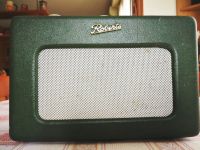 |
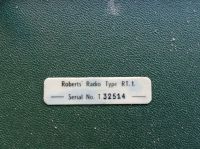 |
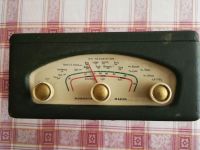 |
 |
||
 |
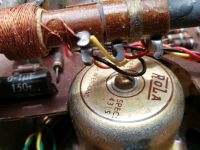 |
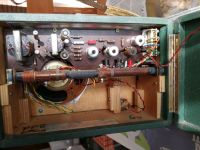 |
 |
||
 La Roberts RT.1 fu lanciata
sul mercato nel 1958 è stata una delle prime radio a transistor a essere
commercializzata nel Regno Unito.
Per l'epoca la RT.1 era un apparecchio portatile piuttosto voluminoso ma ben fatto, con un mobiletto
in legno compensato ricoperto di finta pelle. Come avevano
fatto altre ditte inglesi, anche il mobiletto della RT.1 in precedenza
era stato utilizzato per una serie di radio portatili a valvole, come ad
esempio la R55 e la
R66.
La Roberts RT.1 fu lanciata
sul mercato nel 1958 è stata una delle prime radio a transistor a essere
commercializzata nel Regno Unito.
Per l'epoca la RT.1 era un apparecchio portatile piuttosto voluminoso ma ben fatto, con un mobiletto
in legno compensato ricoperto di finta pelle. Come avevano
fatto altre ditte inglesi, anche il mobiletto della RT.1 in precedenza
era stato utilizzato per una serie di radio portatili a valvole, come ad
esempio la R55 e la
R66.Il circuito elettrico adottato dalla Roberts era ormai diventato un classico. La radio impiegava la serie dei sei transistor PNP al germanio con sigla OC immessi da poco sul mercato dalla Mullard Radio Valve Co. Ltd.: OC44, OC45, OC45, OC71, OC72, OC72. La RT1 era dotata di uno stadio amplificatore a Radio frequenza e mixer (OC44), due stadi di amplificazione della frequenza intermedia a 470 kHz (OC45), stadio preamplificatore audio con l'OC71 e lo stadio finale di potenza con i due OC72 in push pull. L'alimentazione era assicurata da una grossa batteria tipo PP8 da 6 V e la potenza resa in uscita era di circa 300 mW. La ricezione in Onde Medie e Onde Lunghe era forte e il suono corposo per merito del buon altoparlante Rola, della resa acustica del mobile in legno. A causa della direzionalità dell'antenna interna, un lungo nucleo in ferrite, la Roberts RT.1 era montato su un piccolo disco di plastica girevole, che permetteva all'ascoltatore di ruotare il ricevitore per captare il segnale migliore. Questa era una soluzione che caratterizzava i ricevitori radio portatili di qualità dell'epoca. Per l'eventuale utilizzo del ricevitore a bordo di un'automobile nel pannello posteriore della radio era stata prevista una presa di antenna tipo autoradio. La RT.1 uscì di produzione nel 1960 quando fu sostituita dal nuovo modello R200. La Roberts Radio Company è una delle poche ditte inglesi sopravvissute dal periodo di massimo splendore dell'industria elettronica britannica. Negli anni Roberts si è fatta una solida fama per la qualità, oltre che per il ricercato design. Oggi l'Azienda produce ricevitori radio digitali (DAB) di alta qualità, sia in stile moderno che tradizionale. Il Revival 250 (R250) degli anni 90' per esempio, è simile nello stile all'RT.1 degli anni '50. Nella mia collezione sono presenti due esemplari della RT.1, uno con il rivestimento in similpelle verde (matricola T.32514) e l'altro con rivestimento rosso (matricola T.33806). In quello verde ho sostituito la cinghietta per il trasporto che era rotta e incollato qualche angolo del rivestimento in finta pelle che si era staccato. Nessuno dei due ha avuto necessità di particolari riparazioni o tarature, appena collegata l'alimentazione a 6 V hanno funzionato correttamente ricevendo le stazioni in onda media con buona sensibilità. © IK3HIA 2020 |
|||||
|
Return to top of page
|
|||||
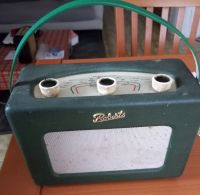 |
 |
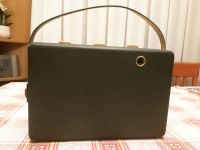 |
 |
||
 The Roberts RT.1 was launched in 1958 and was one of the first
transistor radios to be marketed in the UK. For its time, the RT.1 was a
rather bulky but well-made portable radio, with a plywood cabinet
covered in imitation leather. Like other British companies, the RT.1
cabinet had previously been used for a range of portable valve radios,
such as the
R55 and
R66.
The Roberts RT.1 was launched in 1958 and was one of the first
transistor radios to be marketed in the UK. For its time, the RT.1 was a
rather bulky but well-made portable radio, with a plywood cabinet
covered in imitation leather. Like other British companies, the RT.1
cabinet had previously been used for a range of portable valve radios,
such as the
R55 and
R66.The electrical circuit adopted by Roberts had by then become a classic. The radio used the series of six PNP germanium transistors with the abbreviation OC, recently released on the market by Mullard Radio Valve Co. Ltd.: OC44, OC45, OC45, OC71, OC72, OC72. The RT1 was equipped with a radio frequency amplifier stage and mixer (OC44), two intermediate frequency amplification stages at 470 kHz (OC45), audio preamplifier stage with the OC71 and the final power stage with the two OC72 in push pull. The power supply was ensured by a large 6 V PP8 type battery and the output power was about 300 mW. The reception in Medium Waves and Long Waves was strong and the sound full-bodied thanks to the good Rola speaker, the acoustic performance of the wooden cabinet. Due to the directionality of the internal antenna, a long ferrite core, the Roberts RT.1 was mounted on a small rotating plastic disk, which allowed the listener to rotate the receiver to capture the best signal. This was a solution that characterized the quality portable radio receivers of the time. For the possible use of the receiver on board a car on the rear panel of the radio a car radio type antenna socket was provided. The RT.1 went out of production in 1960 when it was replaced by the new R200 model. The Roberts Radio Company is one of the few British companies to have survived from the heyday of the British electronics industry. Over the years Roberts has built a reputation for quality as well as design. Today the company produces high quality digital radio (DAB) receivers in both modern and traditional styles. The 1990s Revival 250 (R250) for example is similar in style to the 1950s RT.1. I have two examples of the RT.1 in my collection, one with green leatherette upholstery (serial number T.32514) and the other with red upholstery (serial number T.33806). On the green one I replaced the broken carrying strap and glued back a few loose corners of the leatherette upholstery. Neither of them required any particular repairs or calibrations, as soon as the 6V power supply was connected they worked correctly, receiving medium wave stations with good sensitivity. © IK3HIA 2020 |
|||||
 |
 |
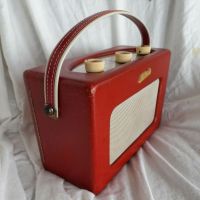 |
 |
||
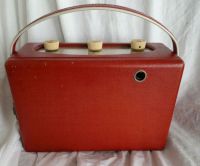 |
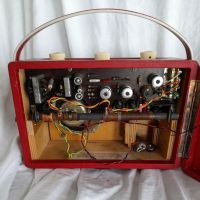 |
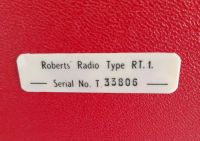 |
 |
||
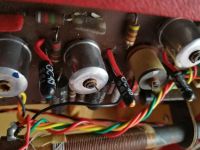 |
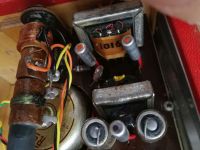 |
 |
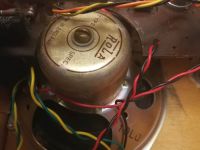 |
||
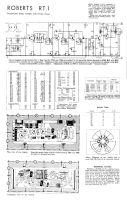 |
 |
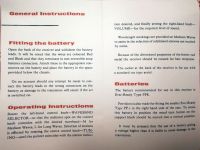 |
|||
|
Return to top of page
|
|||||
|
|
Return to: IK3HIA home page |
|
Return to: Transistor Radio |
|
Go to: Transistor diagrams |